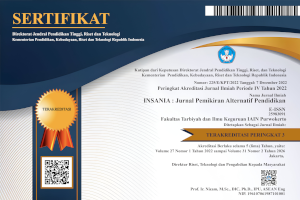Relasi Kepemimpinan dan Kultur Sekolah
DOI:
https://doi.org/10.24090/insania.v21i2.1411Keywords:
School Cultur, LeadershipAbstract
Abstract: The dynamics of scholl has very strong links with leadership. The dominant factor to form a school character and has a competitive advantage in the academic field id dependent on the ability of the proncipal increating a school culture. Establishment of schoool culture begins from building mindset of all school personnel to make changes. This have initiated by school's principal through ongoing innovation. Establishment of an effective school culture requires a long duration efforts and carried simultaneously on all aspects of the schools and the main factor is the headmaster. Finally, the leadership has a very strong relationship in a set up a school culture. Without leadership development, meaningful academic change will not hapen and school become just a passive static routine. Keywords: School Culture, Leadership.Downloads
References
Fullan.2006. Management: Skills and application. San Francisco, Mc Graw-Hill.
Hadari Nawawi, & Martini Hadari. (1995). Kepemimpinan yang efektif. Yogyakarta: Gajah Mada University Press.
Imarah , Muhammad. 2001. Islam dan pluralitas, perbedaan dan kemajemukan dalam bingkai persatuan , terj Abul hayii al kattani. Jakarta : Gema Insani.
Ismail Rodeyah. (2005). Pengaruh kinerja kepemimpinan pendidikandan kinerja guru terhadap prestasi akademik siswa di pendidikan. Diambil pada tanggal 10 Mei 2006, dari http;//www. pages_yourfavorite.com/ppsupi/Abstrak Adpen. 2005.html.
Kim, Daniel. 2013. Leaders who make a difference: Essential strategies for meeting the nonprofit challenge. San Francisco: Josey-Bass.
Kotter, Jhon.2013. Leading Change. London: sage publication.
McCauley.1998. Leadership means always working to meet challenges of changing world Sacramento: Sep/Oct 2009. Vol. 39, Edisi 1; pg. 7, 1
Mifflen, F.J., & Mifflen, S.C. (1986). Sosiologi pendidikan (terjemahan Joost Kullit) Canada: Detselig Enter Prises Ltd (buku asli diterbikan tahun 1982). Bandung: Tarsito
Muhammad Nasir. (2004). Akuntabilitas kepemimpinan manajerial pemimpin pendidikandasar pada era otonomi daerah (Studi Kasus di Kabupaten bengkalis propinsi riau tahun 2003/2004 ). Diambil pada tanggal 10 Mei 2006, dari http;//www.pages_ your favorite.com/ppsupi/Abstrak Adpen.2005.html.
Ogawa, Bossen.1995. Assessing the Contribution of Distributed Leadership to School Improvement and Growth in Math Achievement . American Educational Research Journal. Washington: Sep 2009. Vol. 46, Edisi 3; pg. 659, 31 pgs
Robertson,Jan. 2008. Childhood Education. Leadership Matters Olney: Vol. 86, Edisi 1; pg. 32B, 2 pgs
Ronald H Heck, Philip Halingger. Leadership. Great leaders for Great schools Sacramento: Sep/Oct 2009. Vol. 39, Edisi 1; pg. 659, 4 pgs
Sadler, P. (1997). Leadership. London: Tottenham Court Road.
Saunders, R., Philips, R.C., & Johnson, H.J., (1965). A theory of educational leadership. Columbus: Charles E Merrill Books, Inc.
Shelly Kurtz. 2009 Leadership. Sacramento: Sep/Oct 2009. Vol. 39, Edisi 1; pg. 12, 4. pgs)
Suharsimi Arikunto. (1993). Manajemen pengajaran secara manusiawi. Jakarta: Rineka Cipta.
Sutarto. (1991). Dasar-dasar kepemimpinan administrasi. Yogyakarta: Gajah Mada University Press.
Sykes, Devaney.1988. Organizational behavior. (9th ed.) Englewood Cliff: Prentice-Hall inc.
Teresa, Gerald Bailey.1999.Organizational behavior and management. (5th ed.) San Francisco: Mc Graw. Hill.
Tim Penulis, Depdiknas. (2001). Manajemen peningkatan mutu berbasis pendidikan: Konsep dan pelaksanaan (buku I). Jakarta:.
Valdez, G. (2006). Critical issue: Technology leadership: Enhancing positive educational change. Diambil pada tanggal 14 juli 2006, dari http;// www.nrcel.org/sdrs/pathwayg.html
Wahjosumdjo. (2002). Kepemimpinan pemimpin pendidikan: Tinjauan teoritis dan permasalahannya. Jakarta: Raja Grafindo Persada.
Wayan Koster. (1999). Analisis komparatif antara pendidikan efektif dengan pendidikan tidak efektif. Diambil pada tanggal 13 September 2001, dari http;//www.pdk.go.id/jurnal/31/analisis_komparatif_antara_pendidikan.htm
Whitehead, Dianne.2000. Leading the self – managing school. Washington: the falmer press.
Wiseman.2011. Crafting coherence: How schools strategically manage multiple, external demands, Educational Researcher,33, 16-30.
Yukl, G. (2002), Leadership an organization. (5th ed.) Englewood Cliffs: Prentice-Hall inc.
Published
How to Cite
Issue
Section
License
Authors who publish with this journal agree to the following terms:
Authors retain copyright and grant the journal right of first publication with the work simultaneously licensed under a Creative CommonsAttribution-ShareAlike License that allows others to share the work with an acknowledgment of the work's authorship and initial publication in this journal.
Authors are able to enter into separate, additional contractual arrangements for the non-exclusive distribution of the journal's published version of the work (e.g., post it to an institutional repository or publish it in a book), with an acknowledgment of its initial publication in this journal.
Authors are permitted and encouraged to post their work online (e.g., in institutional repositories or on their website) prior to and during the submission process, as it can lead to productive exchanges, as well as earlier and greater citation of published work (See The Effect of Open Access).








